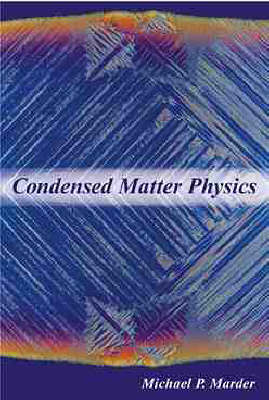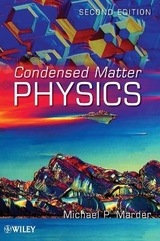
Condensed Matter Physics
John Wiley & Sons Inc (Verlag)
978-0-471-17779-1 (ISBN)
- Titel ist leider vergriffen;
keine Neuauflage - Artikel merken
A modern, unified treatment of condensed matter physics This new work presents for the first time in decades a sweeping review of the whole field of condensed matter physics. It consolidates new and classic topics from disparate sources, teaching "not only about the effective masses of electrons in semiconductor crystals and band theory, but also about quasicrystals, dynamics of phase separation, why rubber is more floppy than steel, electron interference in nanometer--sized channels, and the quantum Hall effect." Six major areas are covered------atomic structure, electronic structure, mechanical properties, electron transport, optical properties, and magnetism. But rather than defining the field in terms of particular materials, the author focuses on the way condensed matter physicists approach physical problems, combining phenomenology and microscopic arguments with information from experiments. For graduate students and professionals, researchers and engineers, applied mathematicians and materials scientists, Condensed Matter Physics provides: An exciting collection of new topics from the past two decades.
A thorough treatment of classic topics, including band theory, transport theory, and semiconductor physics. Over 300 figures, incorporating many images from experiments. Frequent comparison of theory and experiment, both when they agree and when problems are still unsolved. More than 50 tables of data and a detailed index. Ample end--of--chapter problems, including computational exercises. Over 1000 references, both recent and historically significant.
MICHAEL P. MARDER, PhD, is Associate Professor of Physics at the University of Texas at Austin and a member of the internationally known Center for Nonlinear Dynamics.
PART I: ATOMIC STRUCTURE Chapter 1: The Idea of Crystals Introduction Why are Solids Crystalline? Two--Dimensional Lattices Bravais Lattices Enumeration of Two--Dimensional Bravais Lattices Lattices with Bases Primitive Cells Wigner----Seitz Cells Symmetries The Space Group Translation and Point Groups Problems, References Chapter 2: Three--Dimensional Lattices Introduction Distribution Among Elements Monatomic Lattices The Simple Cubic Lattice The Face--Centered Cubic Lattice The Body--Centered Cubic Lattice The Hexagonal Lattice The Hexagonal Close--Packed Lattice The Diamond Lattice Compounds Rocksalt------Sodium Chloride Cesium Chloride Fluorite------Calcium Fluoride Zincblende------Zinc Sulfide Wurtzite------Zinc Oxide Perovskite------Calcium Titanate Classification of Lattices by Symmetry Fourteen Bravais Lattices and Seven Crystal Systems Symmetries of Lattices with Bases Thirty--Two Crystallographic Point Groups Two Hundred Thirty Distinct Lattices Some Macroscopic Implications of Microscopic Symmetries Pyroelectricity Piezoelectricity Optical Activity Problems References Chapter 3: Experimental Determination of Crystal Structures Introduction Theory of Scattering from Crystals Lattice Sums Reciprocal Lattice Miller Indices Scattering from a Lattice with a Basis Experimental Methods Laue Method Rotating Crystal Method Powder Method Further Features of Scattering Experiments Interaction of X--Rays with Matter Production of X--Rays Neutrons Electrons Deciphering Complex Structures Accuracy of Structure Determinations Problems References Chapter 4: Surfaces and Interfaces Introduction Geometry of Interfaces Coherent and Commensurate Interfaces Stacking Period and Interplanar Spacing Other Topics in Surface Structure Experimental Observation and Creation of Surfaces Low--Energy Electron Diffraction (LEED) Reflection High--Energy Electron Diffraction (RHEED) Molecular Beam Epitaxy (MBE) Field Ion Microscopy (FIM) Scanning Tunneling Microscopy (STM) Atomic Force Microscopy (AFM) High Resolution Electron Microscopy (HREM) Problems References Chapter 5: Complex Structures Introduction Alloys Equilibrium Structures Phase Diagrams Superlattices Phase Separation Nonequilibrium Structures in Alloys Dynamics of Phase Separation Simulations Monte Carlo Molecular Dynamics Liquids Correlation Functions Extended X--Ray Absorption Fine Structure (EXAFS) Calculating Correlation Functions Glasses Liquid Crystals Nematics, Cholesterics, and Smectics Liquid Crystal Order Parameter Polymers Ideal Radius of Gyration Quasicrystals One--Dimensional Quasicrystal Two--Dimensional Quasicrystals------Penrose Tiles Experimental Observations Fullerenes Problems References PART II: ELECTRONIC STRUCTURE Chapter 6: The Single--Electron Model Introduction The Basic Hamiltonian Densities of States Definition of Density of States ${D, page {140} Results for Free Electrons Statistical Mechanics of Noninteracting Electrons, Sommerfeld Expansion Specific Heat of Noninteracting Electrons at Low Temperatures Problems References Chapter 7: The Schroedinger Equation and Symmetry Introduction Translational Symmetry------Bloch's Theorem Van Hove Singularities Fourier Analysis of Bloch's Theorem Kronig----Penney Model Rotational Symmetry------Group Representations, Classes and Characters Consequences of point group symmetries for Schr"odinger's equation Problems References Chapter 8: Nearly Free and Tightly Bound Electrons Introduction Nearly Free Electrons Degenerate Perturbation Theory Brillouin Zones Nearly Free Electron Fermi Surfaces Tightly Bound Electrons Wannier Functions Tight Binding Model Problems References Chapter 9: Electron----Electron Interactions Introduction Hartree and Hartree----Fock Equations Variational Principle Hartree----Fock Equations Numerical Implementation Hartree----Fock Equations for Jellium Density Functional Theory Thomas----Fermi Theory Kohn----Sham Equations Stability of Matter Problems References Chapter 10: Calculation of Band Structures Introduction Numerical Methods Pseudopotentials and Orthogonalized Planes Waves (OPW) Linear Combination of Atomic Orbitals (LCAO) Plane Waves Linear Augmented Plane Waves (LAPW) Linearized Muffin Tin Orbitals (LMTO) Definition of Metals, Insulators, and Semiconductors Brief Survey of the Periodic Table Noble Gases Nearly Free Electron Metals Semiconductors Transition Metals Rare Earths Problems References PART III: MECHANICAL PROPERTIES Chapter 11: Cohesion of Solids Introduction Radii of Atoms Noble Gases Ionic Crystals Ewald Sums Metals Use of Pseudopotentials Band Structure Energy Peierls Distortion Structural Phase Transitions Hydrogen--Bonded Solids Cohesive Energy from Band Calculations Classical Potentials Problems References Chapter 12: Elasticity Introduction General Theory of Linear Elasticity Solids of Cubic Symmetry Isotropic Solids Other Constitutive Laws Liquid Crystals Rubber Composite and Granular Materials Problems References Chapter 13: Phonons Introduction Vibrations of a Classical Lattice Normal Modes Lattice with a Basis Vibrations of a Quantum----Mechanical Lattice Phonon Specific Heat Einstein and Debye Models Thermal Expansion Inelastic Scattering from Phonons Neutron Scattering Formal Theory of Neutron Scattering Averaging Exponentials Evaluation of Structure Factor Kohn Anomalies The M"ossbauer Effect Problems References Chapter 14: Dislocations and Cracks Introduction Dislocations Experimental Observations of Dislocations Force to Move a Dislocation One--Dimensional Dislocations: Frenkel----Kontorova Model Two--Dimensional Dislocations and Hexatic Phases Impossibility of Crystalline Order in Two Dimensions Orientational Order Kosterlitz----Thouless----Berezinskii Transition Cracks Fracture of a Strip Stresses Around an Elliptical Hole Stress Intensity Factor Atomic Aspects of Fracture Problems References Chapter 15: Fluid Mechanics Introduction Newtonian Fluids Euler's Equation Navier----Stokes Equation Polymeric Solutions Plasticity Superfluid $^4$He Two--Fluid Hydrodynamics Second Sound Origin of Superfluidity Lagrangian Theory of Wave Function Superfluid 3He Problems References PART IV: ELECTRON TRANSPORT Chapter 16: Dynamics of Bloch Electrons Introduction Drude Model Semiclassical Electron Dynamics Bloch Oscillations k . P Method Effective Mass Noninteracting Electrons in an Electric Field Zener Tunneling Semiclassical Equations from Wave Packets Formal Dynamics of Wave Packets Quantizing Semiclassical Dynamics Wannier----Stark Ladders de Haas----van Alphen Effect Experimental Measurements of Fermi Surfaces, Problems References Chapter 17: Transport Phenomena and Fermi Liquid Theory Introduction Boltzmann Equation Boltzmann Equation Relaxation Time Approximation Relation to Rate of Production of Entropy Transport Symmetries Onsager Relations Thermoelectric Phenomena Electrical Current Effective Mass and Holes Mixed Thermal and Electrical Gradients Wiedemann----Franz Law Thermopower------Seebeck Effect Peltier Effect Thomson Effect Hall Effect Magnetoresistance Giant Magnetoresistance Fermi Liquid Theory Basic Ideas Statistical Mechanics of Quasi--Particles Effective Mass Specific Heat Fermi Liquid Parameters Traveling Waves Comparison with Experiment in 3He Problems References Chapter 18: Microscopic Theories of Conduction Introduction Weak Scattering Theory of Conductivity General Formula for Relaxation Time Matthiessen's Rule Fluctuations Metal----Insulator Transitions Types of Impurities Impurity Scattering and Green's Functions Green's Functions Single Impurity Coherent Potential Approximation Localization Exact Results in One Dimension Scaling Theory of Localization Comparison with Experiment Problems References Chapter 19: Electronics Introduction Metal Interfaces Work Functions Schottky Barrier Contact Potentials Semiconductors Pure Semiconductors Semiconductor in Equilibrium Intrinsic Semiconductor Extrinsic Semiconductor Diodes and Transistors Surface States Semiconductor Junctions Boltzmann Equation for Semiconductors Detailed Theory of Rectification Transistor Inversion Layers Heterostructures Quantum Point Contact Quantum Dot Problems References PART V: OPTICAL PROPERTIES Chapter 20:Phenomenological Theory Introduction Maxwell's Equations Traveling Waves Mechanical Oscillators as Dielectric Function, Kramers----Kronig Relations Application to Optical Experiments The Kubo----Greenwood Formula Born Approximation Susceptibility Many--Body Green Functions Problems References Chapter 21: Optical Properties of Semiconductors Introduction Cyclotron Resonance Electron Energy Surfaces Semiconductor Band Gaps Direct Transitions Indirect Transitions Excitons Mott----Wannier Excitons Frenkel Excitons Electron----Hole Liquid Optoelectronics Solar Cells Lasers Problems References Chapter 22: Optical Properties of Insulators Introduction Polarization Ferroelectrics Clausius----Mossotti Relation Optical Modes in Ionic Crystals Polaritons Polarons Experimental Observations of Polarons Point Defects and Color Centers Vacancies F Centers Electron Spin Resonance and Electron Nuclear Double Resonance Other Centers Franck----Condon Effect Urbach Tails Problems References Chapter 23: Optical Properties of Metals and Inelastic Scattering Introduction Plasma Frequency Metals at Low Frequencies Anomalous Skin Effect Plasmons Experimental Observation of Plasmons Interband Transitions Brillouin and Raman Scattering Brillouin Scattering Raman Scattering Inelastic X--Ray Scattering Photoemission Measurement of Work Functions Angle--Resolved Photoemission Core--Level Photoemission and Charge--Transfer Insulators Problems References PART VI: MAGNETISM Chapter 24: Classical Theories of Magnetism and Ordering Introduction Three Views of Magnetism From Magnetic Moments From Conductivity From a Free Energy Magnetic Dipole Moments Spontaneous Magnetization of Ferromagnets Ferrimagnets Antiferromagnets Mean Field Theory and the Ising Model Domains Hysteresis Other Order----Disorder Transitions Alloy Superlattices Spin Glasses Critical Phenomena Landau Free Energy Scaling Theory Problems References Chapter 25: Magnetism of Ions and Electrons Introduction Atomic Magnetism Hund's Rules Curie's Law Magnetism of the Free--Electron Gas Pauli Paramagnetism Landau Diamagnetism Aharonov----Bohm Effect Tightly Bound Electrons in Magnetic Fields Quantum Hall Effect Integer Quantum Hall Effect Fractional Quantum Hall Effect Problems References Chapter 26: Quantum Mechanics of Interacting Magnetic Moments Introduction Origin of Ferromagnetism Heitler----London Calculation Spin Hamiltonian Heisenberg Model Indirect Exchange and Superexchange Ground State Spin Waves Spin Waves in Antiferromagnets Comparison with Experiment Ferromagnetism in Transition Metals Stoner Model Calculations Within Band Theory Kondo Effect Scaling Theory Hubbard Model Mean--Field Solution Problems References Chapter 27: Superconductivity Introduction Phenomenology of Superconductivity Phenomenological Free Energy Thermodynamics of Superconductors Landau----Ginzburg Free Energy Type I and Type II Superconductors Flux Quantization The Josephson Effect Circuits with Josephson Junction Elements SQUIDS Origin of Josephson's Equations Microscopic Theory of Superconductivity Electron----Ion Interaction Formal Derivation Instability of the Normal State: Cooper Problem Self--Consistent Ground State Thermodynamics of Superconductors Superconductor in External Magnetic Field Derivation of Meissner Effect Comparison with Experiment High--Temperature Superconductors Problems References APPENDICES Appendix A, Lattice Sums and Fourier Transforms, One--Dimensional Sum Area Under Peaks Three--Dimensional Sum Discrete Case Convolution Using the Fast Fourier Transform References Appendix B, Variational Techniques Functionals and Functional Derivatives Time--Independent Schroedinger Equation Time--Dependent Schroedinger Equation Method of Steepest Descent References Appendix C, Second Quantization Rules States Operators Hamiltonians Derivations Bosons Fermions Index
| Erscheint lt. Verlag | 8.2.2000 |
|---|---|
| Zusatzinfo | Illustrations |
| Verlagsort | New York |
| Sprache | englisch |
| Maße | 180 x 260 mm |
| Gewicht | 1559 g |
| Einbandart | gebunden |
| Themenwelt | Naturwissenschaften ► Physik / Astronomie ► Atom- / Kern- / Molekularphysik |
| Naturwissenschaften ► Physik / Astronomie ► Festkörperphysik | |
| ISBN-10 | 0-471-17779-2 / 0471177792 |
| ISBN-13 | 978-0-471-17779-1 / 9780471177791 |
| Zustand | Neuware |
| Haben Sie eine Frage zum Produkt? |
aus dem Bereich



